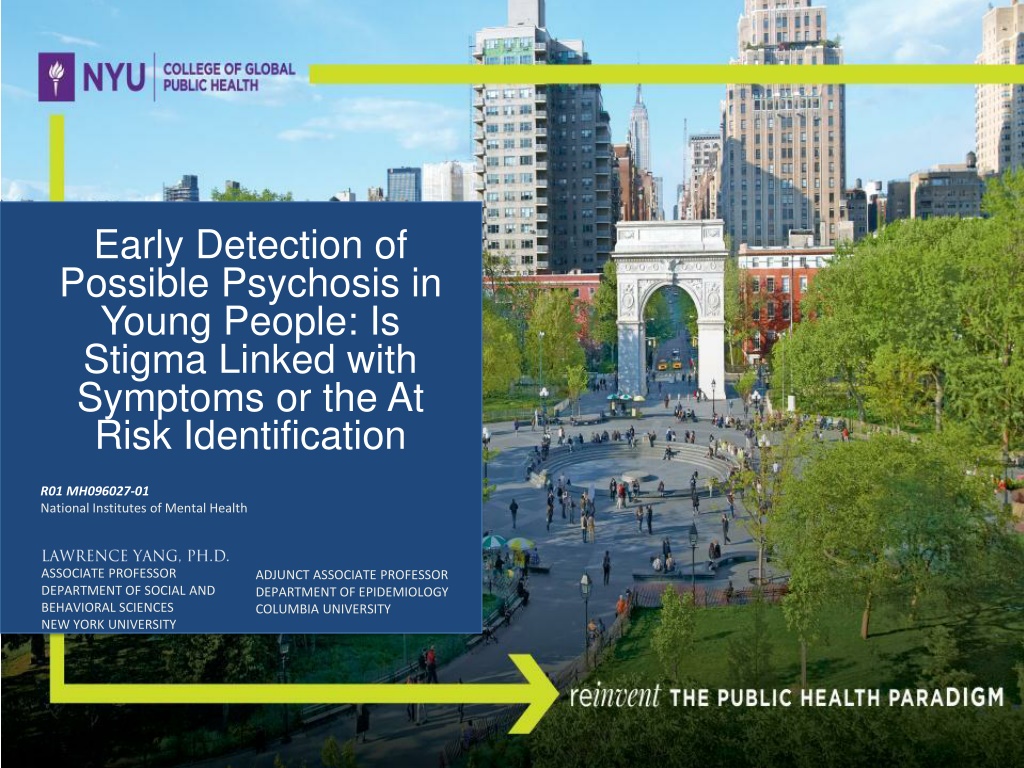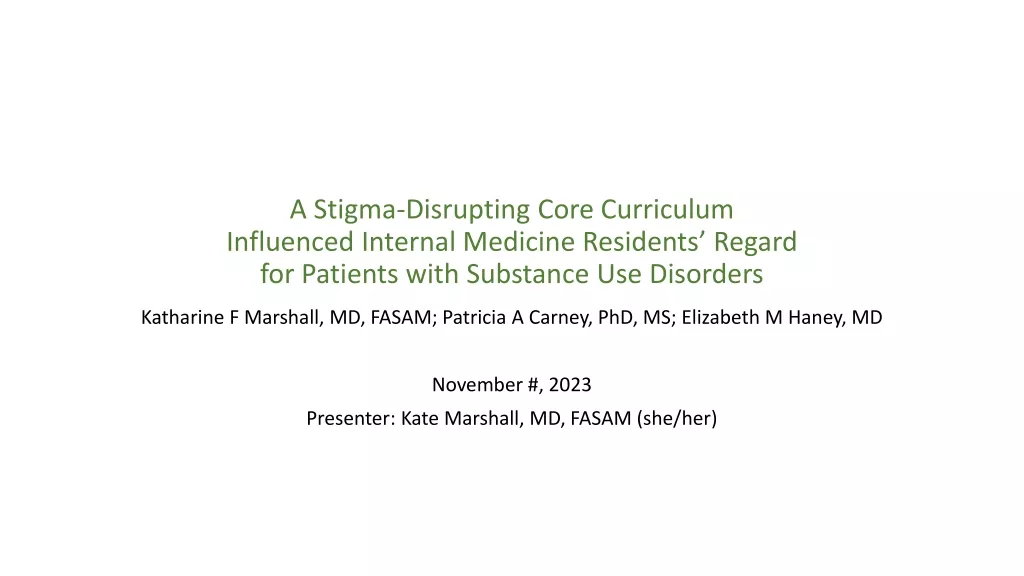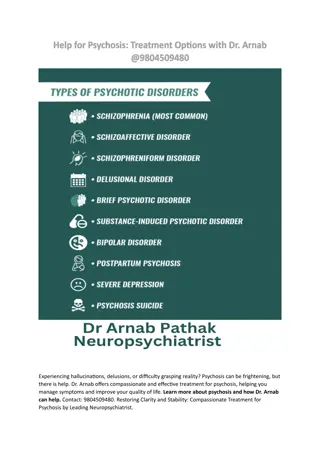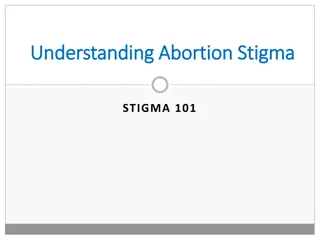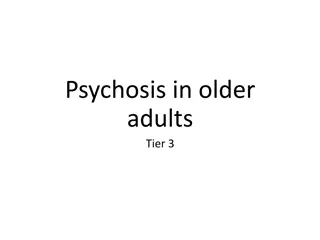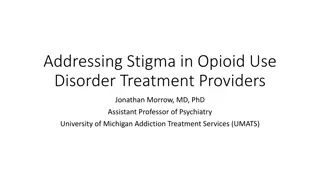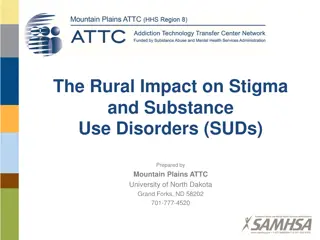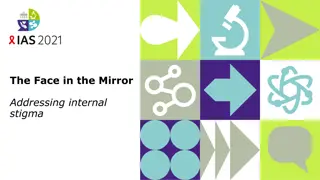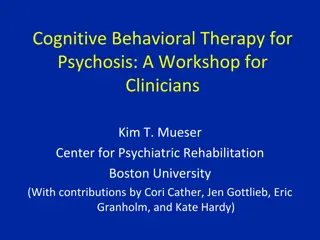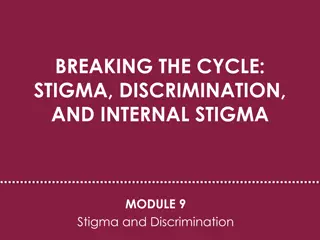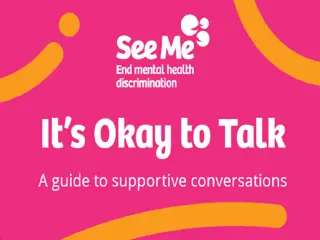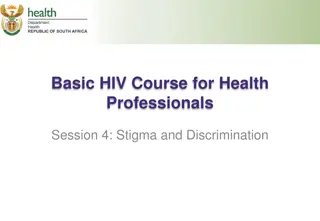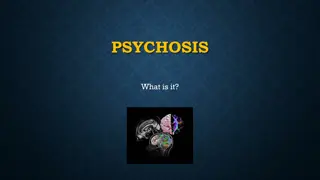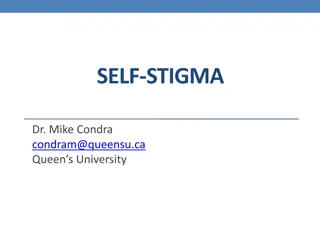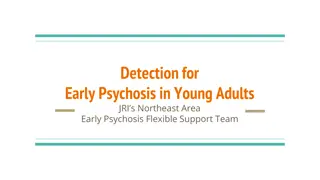Exploring Stigma in Early Detection of Psychosis Among Young People
This research focuses on stigma associated with identifying at-risk individuals for psychosis. It delves into the impact of societal perceptions on mental health outcomes, presenting findings from studies on public stigma, discrimination, and self-stigma. The study also examines how cultural factors influence the course of mental illnesses like schizophrenia and prodromal psychosis. Through various research projects, the aim is to understand and address the challenges posed by stigma in mental health interventions.
Download Presentation

Please find below an Image/Link to download the presentation.
The content on the website is provided AS IS for your information and personal use only. It may not be sold, licensed, or shared on other websites without obtaining consent from the author. Download presentation by click this link. If you encounter any issues during the download, it is possible that the publisher has removed the file from their server.
E N D
Presentation Transcript
Early Detection of Possible Psychosis in Young People: Is Stigma Linked with Symptoms or the At Risk Identification R01 MH096027-01 National Institutes of Mental Health ASSOCIATE PROFESSOR DEPARTMENT OF SOCIAL AND BEHAVIORAL SCIENCES NEW YORK UNIVERSITY ADJUNCT ASSOCIATE PROFESSOR DEPARTMENT OF EPIDEMIOLOGY COLUMBIA UNIVERSITY
DISCLOSURES None 1
RESEARCH BACKGROUND I) Social Factors that influence course of SCZ II) Training in clinical psychology, anthropology and psychiatric epidemiology III) Fieldwork in China IV) Current NIH funding-- R01 Stigma associated with prodromal psychosis; R21 Stigma of genetic attributions in prodromal psychosis R01 Cognition of Untreated Psychosis in China R21- Stigma Intervention for HIV in Botswana U19- Global Hub- South America 2
OVERVIEW I: Stigma s Effects on Mental Health Public stigma Experienced Discrimination & Self stigma Structural stigma II: Stigma and the Clinical High Risk State for Psychosis Initial Quantitative Findings (R01) Qualitative Findings 3
Definition of Stigma Stigma - set of interrelated social processes. Including: labeling, stereotyping, cognitive separating, emotional reactions, status loss and discrimination, and power (Link and Phelan, 2001) Leads to: poorer symptomatic and social outcomes (Link et al, 1989, Corrigan, 2006) 4
PUBLIC STIGMA The process in which the general public stigmatizes individuals with mental illness and which consists of processes of stereotyping, prejudice, and discrimination 5
PUBLIC STIGMA GLOBALLY Cross-National Study of Backbone of Public Stigma of Mental Illness (Pescosolidoet al., 2013) 16 countries-- nationally representative samples DSM-IV Case vignettes (MDD & SCZ) Sample= 13,081 community members core sentiments that represent consistent, salient public health intervention targets 5 items endorsed by >65% of respondents Unwilling to care for children Unwilling to have marry into family Shouldn t teach children Likely to be violent to self Unpredictable 6
EXPERIENCED DISCRIMINATION Experienced discrimination is when an individual is unfairly treated by another individual based on their status of having mental illness 7
Discrimination Globally Cross-National Study of Stigma of Mental Illness (Thornicroft et al., 2009) 732 individuals with SCZ 27 Countries (Europe; N. America; Asia; S. America) 47% Negatively affected in Keeping Friends; 43% Treated differently by family *Greater discrimination associated with greater number of years ill (>5 years; >15 years) --Also increases with: Anticipated stigma and compulsory treatment 8
INTERNALIZED STIGMA Internalized stigma takes place through stigmatized individuals themselves once they become aware of stereotypes and apply stereotypes to themselves. 9
Anticipated Stigma Globally Cross-National Study of Stigma of Mental Illness (Thornicroft et al., 2009) 64% anticipated stigma in finding work 55% anticipated stigma in intimate relationships 72% felt need to Conceal Diagnosis 10
Modified Labeling Theory Step 2 Step 1 Step 5 Step 3 Step 4 Negative Labeled individual s response - e.g., secrecy, withdrawal Labeled: societal conceptions become relevant to self consequences for self-esteem, earning power, or social network ties Vulnerability to new illness or to repeat episodes Societal conceptions of what it means to have mental illness: perceptions of devaluation- discrimination Not Labeled: societal conceptions are irrelevant to self No consequences due to labeling Link et al., 1989 11 11 11
Internalized Stigma Livingston and Boyd, et al., 2010 Self Esteem Self Esteem (19 Studies) r = -.55 Self-Efficacy (7 Studies) r = -.54 Stereotype Awareness Quality of Life (13 Studies) r = -.47 Depressive Symptoms (11 Studies) r = .41 Stereotype Agreement Treatment Adherence r = -.38 Psychosocial (4 Studies) Medication (3 studies) Self Concurrence Social Support (3 Studies) r= -.28 Social Integration Social Network 12
STRUCTURAL STIGMA Institutional practices that work to the disadvantage of the stigmatized group or person 13
STRUCTURAL STIGMA Common Forms Countries spending far less Gross Domestic Product on mental health than physical health Countries forbidding people with mental illness rights and privileges 14
BACKGROUND CHR feedback might be adapted according to relatively lower-level symptoms indicating reduced risk (Cannon et al., 2016).
STIGMA LABELING About being told I am at-risk for or developing psychosis (Yang, Link, Corcoran et al, 2015, SCZ Research) 1) Negative emotions (shame) [X], I have felt ashamed. (3 items) 2) Secrecy I have told no one that [X]. (5 items) 3) Experienced Discrimination [X], people are a little afraid of me. (5 items)
STIGMA Symptoms About my symptoms and experiences 1) Negative emotions (shame) [X], I have felt ashamed. (3 items) 2) Secrecy I have told no one about [X]. (5 items) 3) Experienced Discrimination [X], people are a little afraid of me. (5 items)
HYPOTHESES Main Hypotheses: #1) Compare Labeling vs. Symptom-related stigma #2) Assess to what extent labeling vs. symptom stigma are associated with psychological (self-esteem, quality of life) and social (social functioning, social networks) outcomes in CHR youth
SAMPLE 169 Clinical High Risk (CHR) individuals given stigma assessment at CHR identification and then 6- month follow-up at Harvard, Maine, and Columbia University Medical Centers Study Period: 2012-2017 Baseline Data Only presented (those who meet COPS criteria) Help seeking participants who met 1 SIPS/SOPS criteria: (1) attenuated positive symptom syndrome (2) genetic risk and deterioration syndrome (3) brief intermittent psychotic syndrome. (Miller, 2003) Included those CHR individuals who perceived psychosis risk; excluded those who were not aware of any or did not endorse psychosis-risk
SAMPLE CHARACTERISTICS Participants (n=120) N (%) Mean (SD) Age (in Years) 18.6 (4.2) Sex- Male 80 (66%) Site Boston 56 (47%) Maine 38 (32%) New York 26 (21%) Received CHR Feedback 84 (70%) Years of education 11.7 (3.1) Born in US 110 (91.9%) Preferred Language-English 112 (93.2%) Income (dollars/ year) Less than $19,999 16 (13.5%) $20,000-$59,999 22 (18.2%) Greater than $59,999 32 (27.0%) Comorbid Axis I Symptoms Depression/ MDD 60 (50.7%) Anxiety Disorders 52(43.2%) ADHD 15 (12.8%) Marital Status-Not married 113 (94.6%) Currently Employed (full-time or part time) 35 (29.1%) Enrolled as a Student 92 (76.4%) Race- White+ 74 (61.5%) Family History of Psychosis 34 (28.4%) Symptoms Total positive 13.6 (4.1) Total negative 15.0 (6.5) Total disorganized 7.0 (3.7) Current GAF 46.2 (9.6)
Outcomes Psychological Self-Esteem (Rosenberg Self-Esteem, 1965) Quality of Life (WHO Quality of Life Scale- BREF, 1994) Social Global Functioning: Social Scale (Cornblatt et al, 2007) Loss of Social Networks (Norbeck Social Support Questionnaire; Total loss of relationships/support due to stigma)
Hypothesis #1: Labeling vs. Symptoms Stigma 19 18 17 16 15 14 13 12 11 p <0.0001 10 9 8 7 6 p <0.0001 5 4 3 2 1 Labeling Symptoms Labeling Labeling Symptoms Symptoms Shame (n=116) Secrecy (n=115) Discrimination (n=116)
Psychological: Self-Esteem Linear Regression Models Model 1 (SE) Model 2 (SE) Model 3 (SE) Model 4 (SE) Stigma Variables Panel A. Shame -0.81 (0.25)** --- -0.09 (0.35) -0.17(0.31) Label-Shame --- -1.07 (0.24)*** -1.01 (0.35)** -1.15 (0.32)** Symptoms-Shame 0.09 0.16 0.16 0.43 R2 105 105 105 105 N Panel B. Secrecy 0.17 (0.39) --- -0.04 (0.46) -0.20 (0.42) Label-Secrecy --- 0.43 (0.44) 0.46 (0.52) 0.47 (0.49) Symptoms-Secrecy 0.00 0.01 0.01 0.29 R2 104 104 104 104 N Panel C. Discrimination -0.40 (0.13)** --- -0.39 (0.15)* -0.38 (0.14)** Label-Discrimination --- -0.24(0.14)+ -0.04 (0.16) 0.01 (0.15) Symptoms-Discrimination 0.09 0.03 0.09 0.33 R2 105 105 105 105 N Note: =Beta coefficient; SE=standard error; Model 4: Shame model adjusted covariates: age*, male, site (Maine** and Columbia vs. Harvard), White, positive symptoms, negative symptoms**, disorganized symptoms, and general systems. Secrecy model adjusted covariates: age, male+, site (Maine and Columbia vs. Harvard), White, positive symptoms, negative symptoms*, disorganized symptoms, and general systems. Discrimination model adjusted covariates: include age, male+, site (Maine and Columbia vs. Harvard), White+, positive symptoms, negative symptoms**, disorganized symptoms, and general systems. +P<0.10; *P<0.05; **P<0.01; ***P<0.0001
Psychological: Quality of Life Linear Regression Models Model 1 (SE) Model 2 (SE) Model 3 (SE) Model 4 (SE) Variables Panel A. Shame -1.66 (0.51)** --- -0.26(0.70) -0.07(0.60) Label-Shame --- -2.15(0.49)*** -1.97(0.70)** -1.26(0.62)* Symptoms-Shame 0.09 0.16 0.16 0.47 R2 106 106 106 106 N Panel B. Secrecy 0.97 (0.79) --- 0.48(0.93) 0.13(0.75) Label-Secrecy --- 1.35(0.90) 1.05(1.06) 1.48(0.87)+ Symptoms-Secrecy 0.015 0.02 0.02 0.45 R2 105 105 105 105 N Panel C. Discrimination -0.56(0.26)* --- -0.03(0.28) 0.03(0.24) Label-Discrimination --- -1.18(0.25)*** -1.16(0.29)** -0.84(0.26)** Symptoms-Discrimination 0.04 0.17 0.17 0.49 R2 106 106 106 106 N Note: =Beta coefficient; SE=standard error; Model 4: Shame model adjusted for age**, male, site (Maine and Columbia vs. Harvard), White, positive symptoms, negative symptoms*, disorganized symptoms, and general systems**. Secrecy model adjusted for: age**, male, site (Maine and Columbia vs. Harvard), White, positive symptoms*, negative symptoms**, disorganized symptoms+, and general systems**. Discrimination model adjusted for: age**, male, site (Maine and Columbia vs. Harvard), White, positive symptoms*, negative symptoms**, disorganized symptoms*, and general systems**. +P<0.10; *P<0.05; **P<0.01; ***P<0.0001
Social Scale Linear Regression Models Model 1 (SE) Model 2 (SE) Model 3 (SE) Model 4 (SE) Variables Panel A. Shame -0.04 (0.06) --- 0.03 (0.09) 0.02 (0.07) Label-Shame --- -0.07 (0.06) -0.09 (0.09) -0.08 (0.07) Symptoms-Shame 0.00 0.01 0.01 0.47 R2 109 109 109 109 N Panel B. Secrecy -0.23 (0.09)* --- -0.18 (0.10)+ -0.13 (0.08) Label-Secrecy --- -0.22 (0.10)* -0.12 (0.12) -0.06 (0.09) Symptoms-Secrecy 0.06 0.04 0.07 0.49 R2 108 108 108 108 N Panel C. Discrimination -0.02 (0.03) --- 0.01 (0.03) 0.02 (0.03) Label-Discrimination --- -0.08 (0.03)* -0.07 (0.04)* -0.05 (0.03)+ Symptoms-Discrimination 0.01 0.06 0.06 0.48 R2 109 109 109 109 N Note: =Beta coefficient; SE=standard error; Model 4: Shame model adjusted for: age, male+, site (Maine+ and Columbia* vs. Harvard), White, positive symptoms, negative symptoms***, disorganized symptoms**, and general systems. Secrecy model adjusted for: age, male, site (Maine+ and Columbia** vs. Harvard), White, positive symptoms, negative symptoms***, disorganized symptoms**, and general systems. Discrimination model adjusted for age, male+, site (Maine* and Columbia* vs. Harvard), White, positive symptoms, negative symptoms***, disorganized symptoms**, and general systems. +P<0.10; *P<0.05; **P<0.01; ***P<0.0001
Social Network Loss Linear Regression Models Model 1 (SE) Model 2 (SE) Model 3 (SE) Model 4 (SE) Variables Panel A. Shame 0.18 (0.03)*** 0.11 (0.04)** 0.11 (0.04)** --- Label-Shame 0.17 (0.03)*** 0.09 (0.04)* 0.09 (0.04) --- Symptoms-Shame 0.26 0.24 107 0.29 107 0.32 107 R2 107 N Panel B. Secrecy 0.08 (0.05) --- 0.08 (0.06) 0.11 (0.06)+ Label-Secrecy --- 0.03 (0.06) -0.02 (0.07) -0.02 (0.07) Symptoms-Secrecy 0.02 0.0023 106 0.02 106 0.13 106 R2 106 N Panel C. Discrimination 0.02 (0.02) --- -0.02 (0.02) -0.02 (0.02) Label-Discrimination --- 0.07 (0.02)*** 0.08 (0.02)*** 0.08 (0.02)** Symptoms-Discrimination 0.01 0.15 107 0.16 107 0.22 107 R2 107 N Note: =Beta coefficient; SE=standard error; Model 4: Shame model adjusted for: age, male, site (Maine and Columbia vs. Harvard), White, positive symptoms, negative symptoms, disorganized symptoms, and general systems. Secrecy model adjusted for: age, male*, site (Maine and Columbia vs. Harvard), White, positive symptoms, negative symptoms, disorganized symptoms, and general systems. Discrimination model adjusted for: age, male+, site (Maine and Columbia vs. Harvard), White, positive symptoms, negative symptoms, disorganized symptoms, and general systems. +P<0.10; *P<0.05; **P<0.01; ***P<0.0001
Hypothesis #2: Summary Table. Summary Self-Esteem Quality of Life Social Scale Social Network Loss Labeling Shame NS NS NS S Symptom Shame S S NS NS (T) Labeling Secrecy NS NS (T) NS NS Symptom Secrecy NS NS NS NS (T) Labeling Discrimination S NS NS NS Symptom Discrimination NS S NS (T) S
Qualitative: Most Impacted By Psychosis Purpose: To examine the nature of labeling- related stigma Subjective Experience of being told at CHR (Yang et al, in press, SCZ Research) Qualitatively examine processes including --Positive effects (i.e., operating through direct interaction with specialized CHR clinicians) --Negative effects (i.e., operating as anticipated stigma through CHR individuals themselves). --Co-occurrenceof these
Sample Sample: Thirty-eight (n=38) semi-structured qualitative interviews (2009-2010) to examine the meaning of being of being told they are at CHR Were conducted after CHR identification, on average 11.5 (SD=11.7) months after entering the Columbia site.
Qualitative Questions #1) Any direct treatment from others related to the CHR identification: Is there anything that happened to you in terms of how people treated you, good or bad, as a result of being in this (CHR) program? Probes: Can you give me an example of when you were treated this way? , Who treated you this way? Where/when? , How did it make you feel? How did you respond to it?
Qualitative Questions #2) Any potential effects via internalized processes that were related to CHR identification: In being in this program, you were told you have an increased risk of psychosis compared to your peers. How has this affected how you see yourself and how others see you? Probes: Did being told you are at-risk for psychosis change the way you thought about yourself? If so, how? Are you concerned about how others might react to knowing your at-risk status? , Would others treat you any differently?
Qualitative Analyses NVivo software (V. 11.0) utilized: -- Methodological advantage of quantifying overlap between major codes Focused on the intersection between: 1) Positive and; 2) Negative Labeling Experiences Jaccard s similarity index (j-index), a measure of similarity indicating percentage overlap (range = 0% - 100%) of selected themes.
RESULTS Theme J Definition Examples Overall Positive 0.93 Endorsed a positive experience from being identified as CHR Reflects any one of the below positive code categories It s(being identified as at psychosis-risk is) like having a sore throat. You don t know it will lead to strep throat, you have something indicating something is wrong but it might not develop into strep throat. Accurate Understanding of CHR Risk 0.59 Demonstrates a correct understanding of what it means to have a CHR status using specific language about risk after formal identification Interpersonal Benefits of Disclosure 0.50 Disclosure of the CHR identification leads to a closer or more supportive relationship Other people (participant s friends and family ) are more aware of what I am thinking and feeling because of my CHR status. It is something like they may be more sensitive to me (about) They are more supportive.
RESULTS Theme J Definition Examples Benefits of Specialized CHR Treatment 0.33 Endorsing more tailored treatment as a result of receiving specialized CHR services through psychosis-risk identification Treatment at COPE (the specialized CHR program) has been absolutely amazing. Talking to my therapists, reading different studies, I can think about (my) symptoms and feelings in a different way. I sometimes use coming to COPE (the specialized CHR program) as a way to convey the severity of my problems. I have an illness with symptoms that s being treated medically, and that it s (my symptoms are) legitimate (in response to a co-worker s delegitimizing reaction). Explanation and Legitimization of Symptoms 0.25 The process of being identified as at CHR explains and/or legitimizes previous experiences of symptoms
RESULTS Theme J Definition Examples Overall Negative 0.62 Endorsing a negative experience from being labeled as CHR Reflects any one of the below negative code categories When I first came to COPE (the specialized CHR program), I had some feelings of embarrassment and shame when talking to friends about coming to NYC. I wouldn t tell others I was there to visit COPE. There is a stigma with mental illness. Schizophrenia is a conversation stopper. Shame and Internalized Stigma 0.55 The CHR label induces shame and internalized stigma due to stereotypes of psychosis Perceived Exacerbation of CHR Experiences 0.41 Over-monitoring of CHR symptoms and interpreting them as signs of full psychosis after psychosis-risk identification I ve become one with the symptoms I ve read about. I am constantly on the lookout to see if I have schizophrenia. I have looked so much into my symptoms of schizophrenia, that it has fueled perceptual disturbances I have had.
RESULTS Theme J Definition Examples 0.27 Structural Discrimination Fears of being treated differently in institutions due to the CHR label The whole notion that I might have schizophrenia someday will I be able to achieve certain things I set out to do? Government rules for security clearance are based on mental stability. The fact I was once on antipsychotic drugs is on my record forever. Even if I successfully recover and (hypothetically) want to get a job in the government, it would still be on my record. If I tell them (that I am at risk for developing psychosis), they may think of me as a mental patient that I am dangerous,they shouldn t be around me, afraid of me. 0.22 Anticipated Stigma and Discrimination Expecting that people will think or treat you differently due to the CHR label
RESULTS Co-Occurring Positive and Negative Themes: Over half of the transcripts expressed overlap between positive and negative themes (Jaccards Coefficient=0.55). -- Interpersonal Benefits of Disclosure co-occurring with Altered Perception and/or Negative Treatment from Others (J=0.5). --Individuals perceived interpersonal benefits of disclosing their mental health status, which was joined by a threat of being negatively treated or perceived by others, upon disclosure. To talk about my at-risk status, there was stigma I had; growing up there was family embarrassment about my family s mental illnesses... Having this new status (getting the CHR label by COPE) also scared my mom as well. My mom has a schizophrenic sister... Being identified as at risk equals people thinking you are really developing something . I sometimes use coming to COPE as a way to convey the severity of my problems. People try to be supportive. People make extra efforts, they would check in on me more.
RESULTS -- Accurate Understanding of Risk Status Co-occurring with Perceived Exacerbation of CHR Experiences (J=0.4). --Individuals with an accurate understanding of their risk status were likely to benefit from specialized CHR treatment through accurate understanding; however, this increase in monitoring may contribute to developing anxiety over their experiences. [I now know that] Being CHR conveys a slightly greater risk for a disease. But it is a very complicated concept to explain to people Dr. Kelly (psychiatrist at the CHR program) asks me about perceptual difficulties. I worry that these might be signs of psychosis, but now I can talk about it. At first identification, I was more worried because I thought it meant I was psychotic, and that there was an increase in the possibility that it s (psychosis) really happening. .
discussion Main Findings (Quantitative):
discussion Qualitative Findings:
discussion Implications for clinical care:
acknowledgements Collaborators: Larry J Seidman,Kristen Woodberry (mPI s), Caitlin Bryant, Emily Kline, Dan Shapir, Leda Kennedy Beth Israel Deaconess/ Harvard Medical School William McFarlane (mPI), Donna Downing, Anna Cloutier Maine Medical Center Cheryl Corcoran Mt Sinai School of Medicine Bruce Link UC Riverside Ragy Girgis, Gary Brucato NY State Psychiatric Institute/ Columbia University
RESULTS -- Explanation and Legitimization of Symptoms co-occurring with Anticipated Stigma and Discrimination (J=0.375). --While the CHR identification provided an explanation for and legitimized symptoms, individuals could simultaneously anticipate stigma and discrimination due to this newfound knowledge. The label and description has been positive for me because now I know that it s something. There have been things or symptoms that people have said oh, you should have that checked. It s good to know that it s something , a real thing. I worry how being in COPE would affect my life in the future if anyone ever found out.I wonder if people would decide that I m unfit to be a mother. I m participating in COPE for my children in case they discover that this is genetic. But I worry that it s in my records and that [my records] will come back even if I get better.
